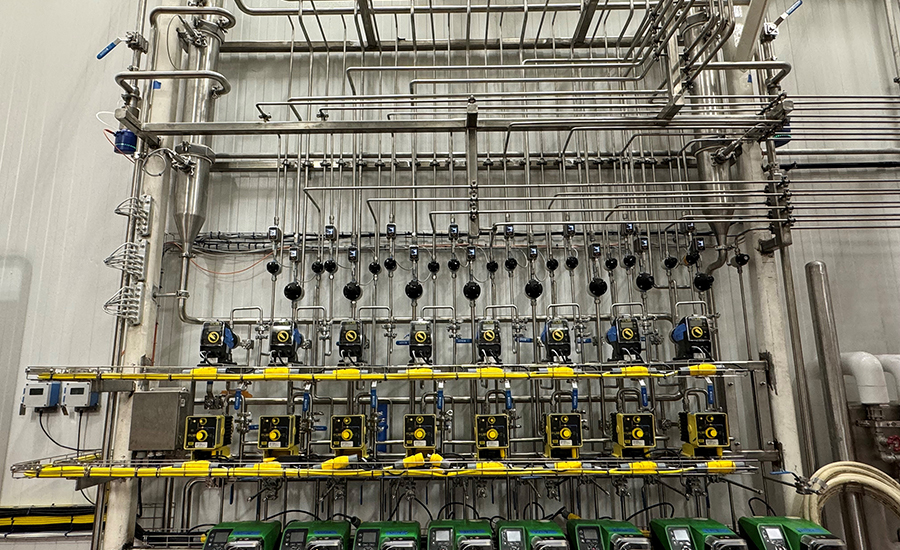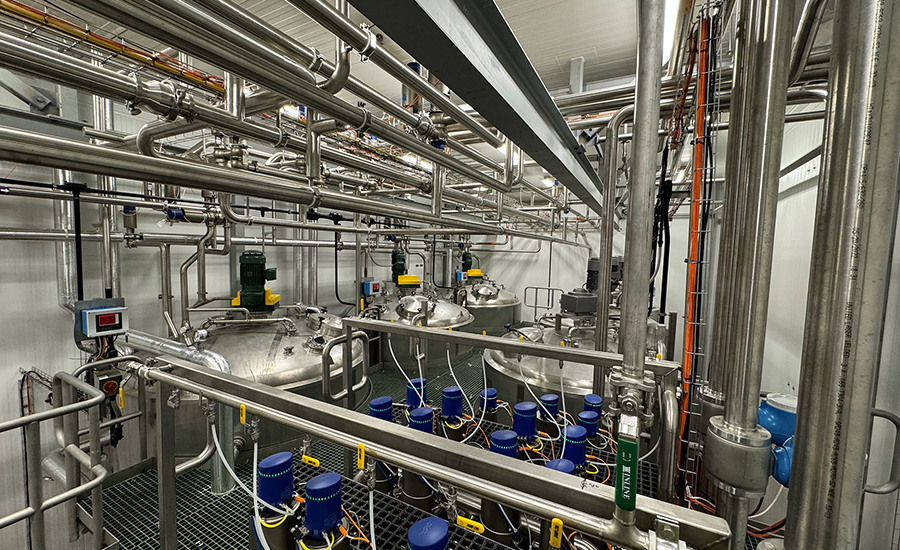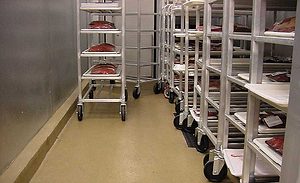2024 Sustainable Plant of the Year
Overcoming Adversity to Implement Sustainability
July 15, 2024
2024 Sustainable Plant of the Year
Overcoming Adversity to Implement Sustainability
July 15, 2024Meati’s Mega Ranch in Thornton Colo., has won FOOD ENGINEERING’s 2024 Sustainable Plant of the Year award. Image courtesy of Dennis Group
When Meati saw a rise in demand for its alternative protein products, it also saw a need to move into new digs to meet that demand. The facility, dubbed the Mega Ranch, has earned FOOD ENGINEERING’s 2024 award for Sustainable Plant of the Year (SPoY).
 Meati founders Tyler Huggins and Justin Whiteley met as grad students at the University of Colorado where the idea of starting a food company based on mycelium was dreamed up. The pair believed in the idea that mycelium-based foods would provide tasty, earth-friendly nutrition for people. Meati’s products are designed as cuts of animal-based proteins, like steak cutlets—one of the relatively few companies offering mycelium foods not done as a ground-style product. That played a role in the sizeable investments in the company from 2020 onward, which greatly helped its ability to grow quickly.
Meati founders Tyler Huggins and Justin Whiteley met as grad students at the University of Colorado where the idea of starting a food company based on mycelium was dreamed up. The pair believed in the idea that mycelium-based foods would provide tasty, earth-friendly nutrition for people. Meati’s products are designed as cuts of animal-based proteins, like steak cutlets—one of the relatively few companies offering mycelium foods not done as a ground-style product. That played a role in the sizeable investments in the company from 2020 onward, which greatly helped its ability to grow quickly.
The growth meant that the company quickly outgrew its pilot facility. A new site was found in Thornton, Colo., just north of Denver—and that’s when things really got interesting.
A Question of Scale
The sustainability behind Meati’s product itself made a large impression on the judges’ decision to award the Mega Ranch SPoY. The company’s founders have gone on record stating that the goal of Meati isn’t to replace animal-based proteins. Instead, the idea is to offer a healthy, sustainable alternative to them.

Part of how Meati is more sustainable is through lower carbon, water and land footprints compared to animal-based counterparts. A mere teaspoon of the company’s mycelium spores is capable of growing into the equivalent of hundreds of cows’ worth of protein in just a few days, all within the confines of its facility walls.
Looking for a reprint of this article?
From high-res PDFs to custom plaques, order your copy today!
“We have done a lifecycle analysis,” says Andrea Wombacher, Meati’s vice president of production, “and pound for pound our mycoprotein, when compared to steak, uses 89% less water, 96% less land use and has an 88% lower carbon footprint. So really, the product in and of itself is a story about sustainability.”
The new space in Thornton, a 100,000-sq.-ft. shell warehouse converted over two phases and essentially separate north and south facilities, was claimed in May of 2021, but because of Covid and concerns regarding equipment availability and lead times, Meati had already been making equipment purchases. Having to scale operations to meet demand meant upsizing from the pilot facility’s 5,000-liter fermentation tanks—essentially the backbone of the facility. Meati went ahead and ordered 25,000-liter fermentation tanks for the Mega Ranch. The problem was getting them into the new facility, which was resolved by taking off the roof and lowering the tanks in—in the middle of winter.
However, the fermenters were taller than the space between the floor and the joists—with the joists being 5-in. deep and the agitator motor sitting just 1-in. below each joist—so the roof couldn’t be set back on exactly as it has been removed. To compensate, a w-flange beam system was installed and a third level was added to the platforms surrounding the tanks. A sanitary walk-on ceiling was installed in the food processing space where exposed product is located.

According to Chris Morse, a project manager with the Dennis Group—which came on for the second phase of the Mega Ranch, the north side—there were questions regarding the utilities and usage that stemmed from the fact that scaling the mycelium growth to where Meati wanted it wasn’t a simple matter of multiplying resource usage from the pilot facility.
“One of the things that really drove our decision making was spending the time upfront looking at diversity and what the typical numbers are regarding how this equipment is going to run,” says Morse. “And then saying, ‘Maybe we don't need this equipment?’”
“I think that that was a big discussion about electricity and being more efficient,” he adds, “trying to create something sustainable that we're not putting such a load on all this equipment that we didn't need to run.” The majority of the facility was electrified with renewable energy to decrease GHG emissions.
Wombacher says that the project team looked at a lot of sustainability requirements to come at the project with a process-oriented, purpose-built, efficient mindset. Being in Colorado with its semi-arid climate and growing population, the limited water supply was of great concern to the City of Thornton. This meant that the team had to make sure there were options for water reuse, especially because of the relatively water-intensive process of creating mycelium-based foods. This resulted in the construction of a 15,000-gal. storage system so that Meati can pull water consistently all the time yet have enough water on hand to accommodate high-demand times. Dennis Group also installed a 150,000-gal. equalization tank for wastewater. Process water is pre-treated and equalized flow is delivered to the city.
Efficiency projects and lifecycle analyses are ongoing for continuous improvement opportunities.
More Intelligent Solutions
“What we’re doing is more focused on process optimization,” Wombacher says regarding the facility’s electricity consumption. “If we can get more from the process and optimize how much biomass we get from each fermentation cycle, that really impacts the ratio of energy usage to pounds out the door.”

Meati’s drop and fill process allows it to get a greater harvest out of each inoculation. Mycelium spores are grown from seed tanks before flowing into a fermentation tank. That broth is then transferred from the fermentation tanks to a custom-designed and built rinsing belt where it’s rinsed before being pumped into a dilution tank. Flavorings are added in a batch tank, and custom draining and molding equipment helps the mycelium take on a cutlet-like structure, giving it a texture similar to animal muscle before being pressed and sliced.
After slicing, a thermoformer vacuum seals the bag to prepare the cutlets for a 165°F sous vide oven that cooks them via steam injection. Chilled water supplied to the oven reduces overall cooking times. Finally, the cuts are then finished and packed for retail and food service customers.
Malisko, a firm known for its expertise in process automation integration, industrial IT and manufacturing intelligence solutions, was approached for off-the-shelf control system solutions to help Meati optimize this process. To that end, Rockwell Automation’s FactoryTalk platform and PlantPAx DCS, with a heavy focus on leveraging the standard Plant PAx Library of Process Objects, were specified.
A key feature is the use of the latest Sequencer Object from Rockwell Automation’s PlantPAx version 5.0, which enables batch-type control without the need for a dedicated batch server. The Sequencer Object provides a flexible controller-based step sequencing solution that reduces engineering time by automating common operator procedures. The step-by-step configuration makes it easy to adjust procedures directly from the HMI displays without having to create or modify custom code in the controller. Malisko augmented this functionality with Microsoft Excel “Pinning” spreadsheets to read/write the sequencer configurations, providing flexibility, scalability and record set documentation familiar to process engineers.
In addition to handling the baseline process automation for each unit, the sequencer is deployed as a batching recipe manager for execution order and parameter management of other sequencers, much like how a unit procedure is handled in ISA-88 batch solutions. This approach allowed for agility in deploying dynamic changes to the process as well as a “regional” control scheme that allows for different master recipes to be deployed to groups of like equipment. The flexible recipe management solution provided Meati with adjustable drop and fill cycle counts, which only require recipe adjustments versus code modifications.
The systems have helped provide insight to conditions for the healthy growth of the sensitive mycelium while allowing Meati to make informed decisions regarding quality and performance.

Putting it All Together
There’s little room for error on any project, especially one with a short timeline. The string of complications that plagued this project would’ve made it understandable had everything devolved into excuses and finger pointing: having to remove the floor to install proper plumbing and drainage, raising the roof to add equipment, terrible weather while the roof was off, permitting issues, having to match the exterior aesthetic of surrounding buildings, and so on.
Morse credits the project team for being flexible and being able to come up with effective solutions quickly while under pressure to finish the project under the wire.
“Right as we were bringing things online, we were still finishing construction,” says Morse. “If you looked at the space, we had a lot of contractors on top of each other, but it turned out well. We got to the finish line.”
Food manufacturers' sustainability efforts are increasingly of concern with consumers. That’s something Meati has taken to heart as a company.
“With the sustainability of our product, the things that we're looking to optimize aren't just with sustainability, but have a lot of indirect impacts on sustainability,” says Wombacher. “We've really started focusing on the R&D side of, ‘How do we get to the base mycoprotein and stop trying to make it chicken?’ in some regard. ‘How do we create products that have even fewer ingredients?’
“We have a very clean label deck when you compare us to other alt proteins. There really aren't that many ingredients with the 95% mycelium that we have grown in house,” she adds. “The fewer ingredients that we have, the fewer logistics, the fewer shipments that we have coming from suppliers. It resonates with the consumer as well when they're looking for that clean label deck. If we can just have basic mycelium that's a delicious fulfilling meat alternative, I think we have something that can really win in the market.”









